How Many Times Should The Bell Ring For Easter Service

Cutaway cartoon of a church building bell, showing construction.
A church building bell in Christian architecture is a bong which is rung in a church for a variety of religious purposes, and can be heard outside the building. Traditionally they are used to call worshippers to the church for a communal service, and to announce the fixed times of daily Christian prayer, called the canonical hours, which number 7 and are contained in breviaries. They are also rung on special occasions such as a wedding ceremony, or a funeral service. In some religious traditions they are used within the liturgy of the church service to signify to people that a particular function of the service has been reached.[1] The ringing of church building bells, in the Christian tradition, is too believed to drive out demons.[2] [iii] [iv]
The traditional European church bell (come across cutaway drawing) used in Christian churches worldwide consists of a cup-shaped metallic resonator with a pivoted clapper hanging inside which strikes the sides when the bell is swung. It is hung within a steeple or belltower of a church or religious building,[5] so the sound can reach a wide area. Such bells are either fixed in position ("hung dead") or hung from a pivoted beam (the "headstock") so they can swing to and fro. A rope hangs from a lever or wheel fastened to the headstock, and when the bell ringer pulls on the rope the bell swings dorsum and forth and the clapper hits the within, sounding the bong. Bells that are hung dead are unremarkably sounded by hitting the audio bow with a hammer or occasionally by a rope which pulls the internal clapper against the bell.
A church may have a unmarried bong, or a collection of bells which are tuned to a common calibration. They may be stationary and chimed, rung randomly past swinging through a small arc, or swung through a full circle to enable the loftier degree of command of English change ringing.
Before modern communications, church building bells were a mutual way to call the customs together for all purposes, both sacred and secular.
Uses and traditions [edit]
Call to prayer [edit]
Oriental Orthodox Christians, such equally Copts and Indians, utilise a breviary such equally the Agpeya and Shehimo to pray the approved hours seven times a day while facing in the eastward management; church bells are tolled, especially in monasteries, to mark these seven fixed prayer times.[6] [7]
In Christianity, some churches ring their church bells from belltowers three times a day, at ix am, 12 pm and 3 pm to summon the Christian true-blue to recite the Lord's Prayer;[8] [9] [10] the injunction to pray the Lord'south prayer thrice daily was given in Didache 8, 2 f.,[eleven] [12] [xiii] which, in plough, was influenced by the Jewish practice of praying thrice daily plant in the Old Testament, specifically in Psalm 55:17, which suggests "evening and morning and at apex", and Daniel half dozen:ten, in which the prophet Daniel prays thrice a day.[11] [12] [14] [fifteen] The early Christians thus came to pray the Lord'southward Prayer at 9 am, 12 pm and iii pm.[16]

Many Cosmic Christian churches ring their bells thrice a day, at 6 am, 12 pm, and vi pm to phone call the faithful to recite the Angelus, a prayer recited in laurels of the Incarnation of God.[17] [18]
Some Protestant Christian Churches ring church bells during the congregational recitation of the Lord'due south Prayer, afterwards the sermon, in order to alert those who are unable to be nowadays to "unite themselves in spirit with the congregation".[19] [20]
In many historic Christian Churches, church bells are also rung on All Hallows' Eve,[21] as well as during the processions of Candlemas and Palm Lord's day;[22] the only time of the Christian Twelvemonth when church building bells are non rung include Maundy Thursday through the Easter Vigil.[23] The Christian tradition of the ringing of church building bells from a belltower is analogous to the Islamic tradition of the adhan from a minaret.[24] [25]
Call to worship [edit]
Most Christian denominations ring church bells to telephone call the true-blue to worship, signalling the start of a mass or service of worship.[19] [26]
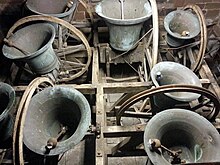
Example of full-circle bells in England in the "upwards" position.
In the Great britain predominantly in the Anglican church, at that place is a strong tradition of modify ringing on full-circle belfry bells for about one-half an hour before a service. This originated from the early 17th century when bell ringers found that swinging a bell through a big arc gave more control over the fourth dimension betwixt successive strikes of the clapper. This culminated in ringing bells through a total circle, which allow ringers hands produce dissimilar striking sequences; known every bit changes.
Exorcism of demons [edit]
In Christianity, the ringing of church bells is traditionally believed to bulldoze out demons and other unclean spirits.[ii] [27] [4] Inscriptions on church bells relating to this purpose of church bells, every bit well as the purpose of serving as a call to prayer and worship, were customary, for case "the sound of this bell vanquishes tempests, repels demons, and summons men".[3] Some churches have several bells with the justification that "the more bells a church had, the more loudly they rang, and the greater the distance over which they could be heard, the less probable it was that evil forces would problem the parish."[27]
Funeral and memorial ringing [edit]
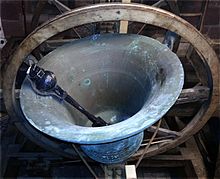
English mode full circle bell with clapper half-muffled. A leather muffle is put over one side but of the clapper ball. This gives a loud strike, then a muffled strike alternately.
The ringing of a church bell in the English language tradition to denote a death is called a decease knell. The blueprint of hit depended on the person who had died; for example in the counties of Kent and Surrey in England it was customary to band three times three strokes for a man and iii times two for a woman, with a varying usage for children.[28] The age of the deceased was then rung out. In small settlements this could effectively identify who had only died.[29]
There were three occasions surrounding a death when bells could be rung. There was the "Passing Bell" to warn of impending death, the second the Death Knell to announce the expiry, and the last was the "Lych Bell", or "Corpse Bong" which was rung at the funeral as the procession approached the church.[29] This latter is known today every bit the Funeral toll.
A more modern tradition where in that location are total-circle bells is to utilise "half-muffles" when sounding one bell as a tolled bong, or all the bells in change-ringing. This means a leather muffle is placed on the clapper of each bong so that at that place is a loud "open" strike followed by a muffled strike, which has a very sonorous and mournful consequence. The tradition in the United Kingdom is that bells are but fully muffled for the death of a sovereign. A slight variant on this rule occurred in 2015 when the basic of Richard III of England were interred in Leicester Cathedral 532 years later his death.[30]
Sanctus bells [edit]

The sacring ring or Gloria wheels used at the St. Jude Thaddeus Church in the erstwhile Spanish colony of the Philippines.
The term "Sanctus bell" traditionally referred to a bell suspended in a bong-cot at the apex of the nave roof, over the chancel arch, or hung in the church tower, in medieval churches. This bong was rung at the singing of the Sanctus and again at the elevation of the consecrated elements, to point to those not present in the building that the moment of consecration had been reached. The exercise and the term remain in common use in many Anglican churches.
Within the body of a church the function of a sanctus bell can also be performed by a small manus bell or set up of such bells (called chantry bells) rung shortly earlier the consecration of the staff of life and wine into the Body and Blood of Christ and over again when the consecrated elements are shown to the people.[31] Sacring rings or "Gloria wheels" are commonly used in Catholic churches in Espana and its former colonies for this purpose.[32]
Orthodox Church building [edit]
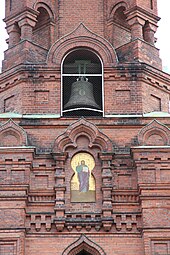
In the Eastern Orthodox Church at that place is a long and circuitous history of bell ringing, with particular bells being rung in particular means to signify different parts of the divine services, Funeral tolls, etc. This custom is particularly sophisticated in the Russian Orthodox Church. Russian bells are usually stationary, and are sounded by pulling on a rope that is fastened to the clapper and so that information technology will strike the within of the bong.[ commendation needed ]
Victory Celebration [edit]
The noon church bell tolling in Europe has a specific historical significance that has its roots in the Siege of Belgrade. Initially, the bell ringing was intended as a phone call to prayer for the victory of the defenders of Belgrade. Yet, because in many European countries the news of victory arrived earlier the order for prayer, the ringing of the church bells was believed to be in celebration of the victory. As a result, the significance of noon bell ringing is now a commemoration of John Hunyadi's victory confronting the Turks.
Other uses [edit]
Clock chimes [edit]
Some churches accept a clock chime which uses a turret clock to broadcast the time by striking the hours and sometimes the quarters. A well-known musical striking blueprint is the Westminster Quarters. This is simply done when the bells are stationary, and the clock mechanism actuates hammers striking on the exterior of the sound-bows of the bells. In the cases of bells which are normally swung for other ringing, there is a manual lock-out machinery which prevents the hammers from operating whilst the bells are being rung.
Alarm [edit]
In Globe War Ii in Bully Britain, all church building bells were silenced, to ring only to inform of an invasion past enemy troops.[33] Yet this ban was lifted temporarily in 1942 by guild of Winston Churchill. Starting with Easter Sunday, April 25, 1943, the Command of Noise (Defence) (No. 2) Order, 1943, immune that church bells could be rung to summon worshippers to church on Sundays, Good Friday and Christmas Day.[34] [35] On May 27, 1943, all restrictions were removed.[36]
In the 2021 German floods information technology was reported that church building bells were rung to warn inhabitants of coming floods.[37] In Beyenburg in Wuppertal the last friar of Steinhaus Abbey rang the tempest bells afterwards other systems failed.[38] Some church bells are being used in England for like purposes.[39]
Design and ringing technique [edit]
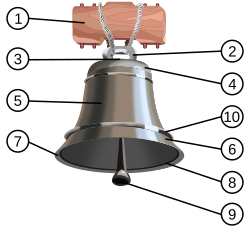 Parts of a typical tower bell hung for swinging: one. yoke, or headstock ii. canons, three. crown, four. shoulder, 5. waist, 6. sound bow, 7. lip, eight. mouth, nine. clapper, 10. bead line |
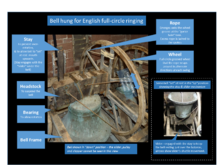
Mechanism of a bong hung for English language full-circle ringing. The bong tin can swing through just over a full circle in alternate directions.
Christian church building bells have the form of a cup-shaped cast metal resonator with a flared thickened rim, and a pivoted clapper hanging from its centre inside. It is commonly mounted loftier in a bell tower on meridian of the church, so it tin be heard by the surrounding customs. The bong is suspended from a headstock which tin swing on bearings. A rope is tied to a wheel or lever on the headstock, and hangs downwards to the bell ringer. To band the bell, the ringer pulls on the rope, swinging the bong. The motility causes the clapper to strike the inside of the bell rim as it swings, thereby sounding the bell. Some bells have full-circumvolve wheels, which is used to swing the bell through a larger arc, such equally in the United Kingdom where total- circumvolve ringing is practised.
Bells which are not swung are "chimed", which means they are struck by an external hammer, or by a rope attached to the internal clapper, which is the tradition in Russia.
Blessing of bells [edit]
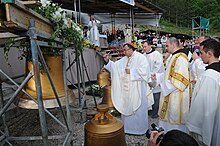
Ceremony of blessing of the bell in Hungary
In some churches, bells are oft blessed before they are hung.
In the Roman Catholic Church the name Baptism of Bells has been given to the ceremonial approving of church building bells, at to the lowest degree in French republic, since the eleventh century. It is derived from the washing of the bell with holy water by the bishop, earlier he anoints information technology with the "oil of the infirm" without and with chrism within; a fuming censer is placed under it and the bishop prays that these sacramentals of the Church may, at the audio of the bell, put the demons to flying, protect from storms, and call the true-blue to prayer.[ citation needed ]
History [edit]
Before the introduction of church bells into the Christian Church, unlike methods were used to call the worshippers: playing trumpets, hit wooden planks, shouting, or using a courier.[twoscore] In Advertisement 604, Pope Sabinian officially sanctioned the usage of bells.[41] [42] These tintinnabula were made from forged metal and did non have large dimensions.[40] Larger bells were made at the cease of the seventh and during the 8th century by casting metal originating from Campania. The bells consequently took the proper noun of campana and nola from the eponymous metropolis in the region.[xl] This would explain the evidently erroneous attribution of the origin of church bells to Paulinus of Nola in AD 400.[forty] [41] [43] Past the early Centre Ages, church bells became common in Europe.[44] They were first mutual in northern Europe, reflecting Celtic influence, particularly that of Irish gaelic missionaries.[44] Before the utilise of church bells, Greek monasteries would ring a apartment metal plate (see semantron) to announce services.[44] The signa and campanae used to announce services earlier Irish influence may have been apartment plates like the semantron rather than bells.[44] The oldest surviving circumvolve of bells in Cracking U.k. is housed in St Lawrence Church, Ipswich.[45]
In literature [edit]
The evocative audio of church bells has inspired many writers, both in poesy and prose. One example is an early poem by the English poet Letitia Elizabeth Landon entitled but, ![]() Bells.
Bells.
Controversies about racket [edit]
The sound of church bells is capable of causing noise that interrupts or prevents people from sleeping. A 2013 study from the Swiss Federal Institute of Technology in Zurich found that 'An estimated 2.5-3.five percentage of the population in the County of Zurich experiences at least one additional awakening per night due to church bong noise.' Information technology concluded that 'The number of awakenings could exist reduced by more than than 99 percent by, for example, suspending church bell ringing between midnight and 06 h in the morning', or by 'about 75 percent (...) past reducing the sound-pressure levels of bells by v dB.'[46]
In the netherlands, in that location have been lawsuits most church bell noise pollution experienced by nearby residents.[47] The complaints are normally, simply non ever, raised by new local residents (or tourists who spend the night in the neighbourhood[48] who are non used to the noise at nighttime or during the day.[48] Local residents who had been used to it for longer usually antiphon that the newcomers 'should accept known this earlier they moved hither' and that the ringing bells 'belong to the local tradition', which sometimes goes back more than a hundred years.[49] [fifty]
Epitome gallery [edit]
-
Tsar Bell in Moscow, Russia, the heaviest existing bell in the world (over 196 tons)
-

-

-

-

-

Ring of 8 bells in the tower of St Michael and All Angels' parish church, Blewbury, Oxfordshire
-

Bell in the Saint-Jacques church of Tournai
See too [edit]
- Bellfounding
- Bolognese bong ringing art
- Campanology
- Central Council of Church Bell Ringers
- Change ringing
- Handbells
- Loudspeakers in mosques
- Ring of bells
- Russian Orthodox bell ringing
- Veronese bellringing art
References [edit]
- ^ Church Words: Origins and Meanings. Frontward Movement. August one, 1996. ISBN9780880281720 . Retrieved Baronial 16, 2012.
There are two sorts of liturgical bells in the history of the Christian Church building-church bells in spires or towers used to phone call the faithful to worship, and sanctuary bells used to call attention to the coming of Christ in the Holy Eucharist.
- ^ a b Booth, Mark (Feb 11, 2014). The Sacred History: How Angels, Mystics and Higher Intelligence Fabricated Our World. Simon and Schuster. p. 274. ISBN9781451698589.
Church building bells would exist rung to drive away demons.
- ^ a b Cohen, I. Bernard (1990). Benjamin Franklin's Science . Harvard University Press. p. 119. ISBN9780674066595.
The practice of ringing church bells to misemploy lightning storms and prevent their deleterious effects had a long tradition in Europe and had been a concomitant to the general belief in the diabolical agency manifested in storms. ... Typical inscriptions on church bells described their powr to "ward off lightning and malignant demons"; stated that "the sound of this bong vanquishes tempests, repels demons, and summons men," or exhorted it to "praise God, put to flight the coulds, affright the demons, and call the people"; or noted that "it is I who dissipate the thunders."
- ^ a b Lewis, James R. (2001). Satanism Today. ABC-CLIO. ISBN9781576072929.
- ^ Adato, Joseph; Judy, George. The Percussionist's Dictionary. Alfred Music. p. 11. ISBN9781457493829.
- ^ "What is the human relationship between bells and the church? When and where did the tradition brainstorm? Should bells ring in every church?". Coptic Orthodox Diocese of the Southern United states of america. 2020. Retrieved August 8, 2020.
- ^ Mary Cecil, 2nd Baroness Amherst of Hackney (1906). A Sketch of Egyptian History from the Primeval Times to the Nowadays Solar day. Methuen. p. 399.
Prayers 7 times a twenty-four hour period are enjoined, and the most strict amid the Copts recite one of more than of the Psalms of David each fourth dimension they pray. They e'er wash their hands and faces before devotions, and turn to the Due east.
- ^ George Herbert Dryer (1897). History of the Christian Church building. Curts & Jennings.
…every church-bell in Christendom to exist tolled 3 times a day, and all Christians to echo Pater Nosters (The Lord's Prayer)
- ^ Joan Huyser-Honig (2006). "Uncovering the Blessing of Fixed-60 minutes Prayer". Calvin Institute of Christian Worship.
Early on Christians prayed the Lord'south Prayer three times a solar day. Medieval church bells called people to common prayer.
- ^ "Church bells". Wisconsin Evangelical Lutheran Synod. July 25, 2017. Retrieved August 8, 2020.
- ^ a b Gerhard Kittel; Gerhard Friedrich (1972). Theological Lexicon of the New Testament, Book 8. William B. Eerdmans Publishing Visitor. p. 224. ISBN9780802822505 . Retrieved October 26, 2012.
The praying of the Lord's Prayer three times a day in Did., 8, ii f. is continued with the Jewish practice --> 218, 3 ff.; II, 801, 16 ff.; the altering of other Jewish customs is demanded in the context.
- ^ a b Roger T. Beckwith (2005). Agenda, Chronology, and Worship: Studies in Ancient Judaism and Early on Christianity. Brill Publishers. p. 193. ISBN9004146032 . Retrieved October 26, 2012.
The Church had now two hours of prayer, observed individually on weekdays and corporately on Sundays – nonetheless the Sometime Testament spoke of iii daily hours of prayer, and the Church itself had been saying the Lord's Prayer three times a day.
- ^ Matthew: A Shorter Commentary. Continuum International Publishing Group. 2005. ISBN9780567082497 . Retrieved August 16, 2012.
Moreover, the cardinal portion of the Eighteen Benedictions, just like the Lord's Prayer, falls into two distinct parts (in the start half the petitions are for the individuals, in the 2nd half for the nation); and early Christian tradition instructs believers to say the Lord's Prayer three times a twenty-four hour period (Did. eight.3) while continuing (Apost. const. 7.24), which precisely parallels what the rabbis demanded for the 18 Benedictions.
- ^ James F White (September i, 2010). Introduction to Christian Worship 3rd Edition: Revised and Enlarged. Abingdon Printing. ISBN9781426722851 . Retrieved October 12, 2012.
Late in the first century or early in the 2d, the Didache brash Christians to pray the Lord's prayer 3 times a day. Others sought disciplines in the Bible itself equally ways to brand the scriptural injunction to "pray without ceasing" (1 Thess. v:17) practical. Psalm 55:17 suggested "evening and forenoon and at noon," and Daniel prayed three times a solar day (Dan. 6:x).
- ^ Catechism Of The Catholic Church. Continuum International Publishing Group. 1999. ISBN0-860-12324-3 . Retrieved September two, 2014.
Tardily in the first century or early in the 2nd, the Didache brash Christians to pray the Lord'south prayer 3 times a solar day. Others sought disciplines in the Bible itself as ways to brand the scriptural injunction to "pray without ceasing" (i Thess. 5:17) practical. Psalm 55:17 suggested "evening and morning and at apex," and Daniel prayed three times a day (Dan. 6:10).
- ^ Beckwith, Roger T. (2005). Calendar, Chronology And Worship: Studies in Ancient Judaism And Early Christianity. BRILL. ISBN978-90-04-14603-7.
So three small hours of prayer were developed, at the third, sixth and 9th hours, which, equally Dugmore points out, were ordinary divisions of the day for worldly diplomacy, and the Lord's Prayer was transferred to those hours.
- ^ John P. Anderson (2009). Joyce's Finnegans Wake: The Curse of Kabbalah, Volume 2. Universal Publishers. ISBN9781599429014 . Retrieved August 16, 2012.
The Angelus is a Christian devotion in retentiveness of the Incarnation. Its proper noun is derived from the opening words, Angelus Domini nuntiavit Mariæ. It consists of iii Biblical verses describing the mystery, recited as versicle and response, alternating with the salutation "Hail Mary!" and traditionally is recited in Cosmic churches, convents and monasteries three times daily, 6:00 a.m., 12:00 noon and 6:00 p.m., accompanied by the ringing of the Angelus bell. Some High Church Anglican and Lutheran churches as well use the devotion.
- ^ The Anglican Service Volume: A Traditional Language Accommodation of the 1979 Book of Common Prayer, Together with the Psalter Or Psalms of David and Additional Devotions. Adept Shepherd Press. September 1, 1991. ISBN9780962995507 . Retrieved August 16, 2012.
The Angelus: In many churches the bong is run forenoon, noon, and evening in retention of the Incarnation of God, and the faithful say the post-obit prayers, except during Eastertide, when the Regina coeli is said.
- ^ a b The New Schaff-Herzog Encyclopedia of Religious Thought: Basilica-Chambers, Volume two. Kessinger Publishing. 1952. p. 117.
The principal use of bells has always been to announce the fourth dimension of public worship. It is also a common Roman Cosmic practice to ring the church bell at the induction in the mass, every bit in some Protestant localities at the Lord's Prayer after the sermon, that those who are absent-minded may unite themselves in spirit with the congregation.
- ^ The Valley's Legends & Legacies Iv. Quill Commuter Books. May thirty, 2002. p. 223. ISBN9781884995217 . Retrieved October 26, 2012.
At the end of the sermon, both bells began to ring and connected ringing through the Lord's Prayer.
- ^ Bannatyne, Lesley (August 31, 1998). Halloween. Pelican Publishing Company. p. 22. ISBN9781455605538.
Priests in tiny Spanish villages still ring their church bells to remind parishioners to award the dead on All Hallows Eve.
- ^ Church Words: Origins and Meanings. Forward Movement. August 1, 1996. ISBN9780880281720 . Retrieved August 16, 2012.
Information technology is too traditional that the church bells band during the processions of Candlemas (the Feast of the Purification) and Palm Sun.
- ^ Church building Words: Origins and Meanings. Frontward Move. August 1, 1996. ISBN9780880281720 . Retrieved August 16, 2012.
It is traditional that no bells be rung from the last service on Maundy Thursday until the Peachy Vigil of Easter.
- ^ Church Words: Origins and Meanings. Psychology Printing. August 1, 1996. ISBN9780880281720 . Retrieved Baronial 16, 2012.
But even for Muslims who pray infrequently, the adhan marks the passage of time through the day (in much the same way as church bells do in many Christian communities) and serves as a constant reminder that they are living in a Muslim community.
- ^ Islamic Beliefs, Practices, and Cultures . Marshal Cavendish. September 1, 2010. p. 77. ISBN9780761479260 . Retrieved August 16, 2012.
Muslims living in predominantly Islamic lands, yet, have the benefit of the call to prayer (adhan). In the aforementioned manner that much of the Christian earth traditionally used bells to summon the faithful to church services, and then the early on Muslim community developed its own method of informing the community that the time for prayer had arrived.
- ^ Church Words: Origins and Meanings. Frontward Movement. Baronial i, 1996. ISBN9780880281720 . Retrieved August 16, 2012.
It became customary to band the church bells to call the faithful to worship and on other important occasions, such as the expiry of a parishioner.
- ^ a b Fanthorpe, Lionel; Fanthorpe, Patricia (October 1, 2002). The World's Most Mysterious Objects. Dundurn. p. 100. ISBN9781770707580.
- ^ Stahlschmidt, J. C. L. (1887). The Church Bells of Kent: Their Inscriptions, Founders, Uses and Traditions. London: Elliot Stock. p. 126.
- ^ a b H B Walters, The Church bells of England. published 1912 and republished 1977 by Oxford University Press. pp156-160
- ^ Bob Triples, fully muffled bells on YouTube
- ^ General Didactics of the Roman Missal, 150
- ^ Herrera, Matthew D. (2005). Sanctus Bells. Their History and Employ in the Catholic Church. Adoremus Bulletin. Retrieved on November 11, 2014.
- ^ Historic period Concern Shropshire (May 9, 2005). "Recollections of a Wartime Childhood". WW2 People's War. BBC.
- ^ "Ringing of Church Bells (1943)". Parliamentary Debates (Hansard). House of Lords. April xx, 1943. Retrieved July ii, 2021.
- ^ "Ban on Ringing of Church building Bells during WW2".
- ^ "Church Bell Ringing (Removal of Restrictions)". Parliamentary Debates (Hansard). Firm of Commons. May 27, 1943. Retrieved July 2, 2021.
- ^ "Residents say flood-hit German towns got little warning | AP News". Associated Press. July 24, 2021.
- ^ Gathmann, Florian (July 23, 2021). "Catastrophic Flooding Spotlights Deutschland's Poor Disaster Preparedness". Der Spiegel.
- ^ "Starcross SOS church bells to warn of flood - BBC News". BBC News. February 24, 2019.
- ^ a b c d Buse, Adolf (1858). Due south. Paulin évêque de Nole et son siècle (350-450) (in French). Translated by Dancoisne, L. Paris: H. Casterman. pp. 415–418.
- ^ a b Roger J. Smith (1997). "Church building Bells". Sacred Middle Catholic Church and St. Yves Mission.
Bells came into employ in our churches every bit early on as the twelvemonth 400, and their introduction is ascribed to Paulinus, bishop of Nola, a town of Campania, in Italy. Their use spread rapidly, equally in those unsettled times the church-bong was useful not only for summoning the faithful to religious services, but also for giving an alarm when danger threatened. Their utilise was sanctioned in 604 by Pope Sabinian, and a ceremony for approval them was established a fiddling later. Very big bells, for church towers, were probably not in common utilize until the eleventh century.
- ^ Henry Beauchamp Walters (1908). Church Bells. A. R. Mowbray & Company. p. iv.
- ^ Kathy Luty; David Philippart (1997). Clip Notes for Church building Bulletins - Volume 1. ISBN9781568541693.
The get-go known utilise of bells in churches was by a bishop named Paulinus in the year 400.
- ^ a b c d Bells. Catholic Encyclopedia.
- ^ Worthington, Mark (September 10, 2009). "Oldest ring of bells played again". BBC News. Retrieved September 10, 2009.
- ^ Omlin, S.; Brink, K. (October 2013). "Awakening effects of church bell noise: geographical extrapolation of the results of a polysomnographic field study i". Noise & Health. Medknow Publications. 15 (66): 332–41. doi:10.4103/1463-1741.116582. PMID 23955130.
- ^ "Kerkklok op mute". RTL Nieuws. August two, 2019. Retrieved Oct 8, 2019.
- ^ a b "Kerkklok beiert hotelgasten wakker". Hart van Nederland. May 12, 2018. Retrieved October 8, 2019.
- ^ Niels Dekker (July 26, 2015). "Klokgelui van de kerken, een zegen of een vloek?". Algemeen Dagblad . Retrieved Oct 8, 2019.
- ^ Geraldina Metselaar (February 25, 2018). "Geluid van carillon drijft omwonende tot wanhoop". Algemeen Dagblad . Retrieved October 8, 2019.
External links [edit]
-
 Media related to Church bells at Wikimedia Commons
Media related to Church bells at Wikimedia Commons - Animation of English language Full-circumvolve church bell ringing
- Video of English full circle-ringing, eight bells one-half muffled and one bell tolling
- Video of English full circle-ringing, 8 bells ringing "open"
- Sound of Bells - An Investigation into their tuning
- Research and Identification of Valuable Bells of the Historic and Culture Heritage of Bulgaria and Development of Audio and Video Archive with Advanced Technologies
- Bell-Ringing Primal
- One-time archive image of church bells in Chatham, Kent, England, ca.1900
- All Saints Bell Tower
How Many Times Should The Bell Ring For Easter Service,
Source: https://en.wikipedia.org/wiki/Church_bell
Posted by: henryresprommed.blogspot.com



0 Response to "How Many Times Should The Bell Ring For Easter Service"
Post a Comment